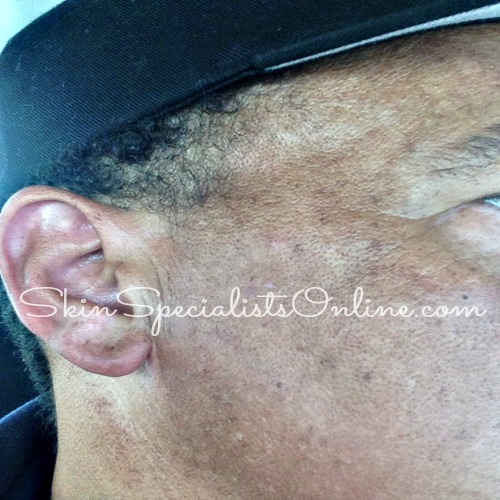
Dear Doctor
Color change in my face and no luck
Dear Patient
Your symptoms are suggestive of Solar Lentigo which are also known as sun spots, age spots or liver spots.
Causes of Solar Lentigo or Sun Spots
Solar lentigo or sun spots are caused by exposure to UV rays from the sun since this stimulates cells in the skin known as melanocytes to produce the skin pigment known as melanin.
Symptoms of Solar Lentigo or Sun Spots
These lesions usually present as flat, brown spots on sun-exposed areas like the face, neck and hands. They have a well-defined margin and they are not itchy.
Treatment of Solar Lentigo or Sun Spots
At Home Treatment
At home treatment of these dark spots on the skin includes the use of:
1. Sunscreens
Broad spectrum sunscreens that offer protection from UVA and UVB rays and that have a sun protection factor (SPF) of at least 30 should be used every day.
Protective clothing with long sleeves and slacks that cover the legs should be worn when out in the sun together with wide brimmed sun hats and UV 400 sunglasses.
2. Skin Brighteners
Skin brighteners which can be used to lighten the hyperpigmented patches include:
a. Vitamin C or ascorbic acid which reduces melanin production. It is found in products like Olay Total Effects tone correcting night moisturizer and LumiEssence Organic Brightening Treatment.
b. Kojic acid is derived from fungi and it lightens areas by interfering with the activity of tyrosinase. It is found in products like LumiEssence Organic Brightening Treatment.
3. Mild Chemical Peels
Mild or superficial chemical peels like glycolic acid peels can be used to manage them. Glycolic acid is a naturally occurring alpha hydroxyl acid (AHA) which loosens the glue that holds dead cells on the surface of the skin together. By exfoliating these dead cells it gives the skin a more even tone and youthful appearance. 30% Glycolic acid peels can be bought over the counter and they can be used at home monthly for 8 to 10 months.
4. Hydroquinone
Hydroquinone is a skin bleach which reduces melanin formation by interfering with the activity of the enzyme known as tyrosinase. It is available over the counter at concentrations of 1% and 2% in products like Ambi Fade Cream with 2% hydroquinone. Its use must be combined with the daily application of a broad spectrum sunscreen on top of it since exposure to the sun reverses its effects and causes repigmentation. Hydroquinone can irritate sensitive skin and cause ochronosis which is unusual bluish-black darkening of the skin. It is also thought to cause cancer.
5. Cover-Up Makeup
Cover-up makeup usually comes as sets which include concealing creams and setting powder. Examples include the Smart Cover-up Starter Kit and Dermablend Cover Cream.
Before use the skin should be cleaned with soap and water. The concealing cream foundation should then be applied to the discolored patches. This cream foundation should be 1 or 2 shades lighter/darker than the surrounding skin. The loose powder is then dusted lightly over the area.
Dermatologist Treatment
Medications used to treat Solar Lentigines include:
1. Topical Retinoids
Retinoids which are applied on the skin like tretinoin (Retin A) are also used to treat these dark spots.
2. Skin Bleaches
Higher concentrations of Hydroquinone (3% and higher) can also be prescribed for these lesions.
3. Lasers
Laser resurfacing can be done to even out the pigmentation over a large area by removing the top layer of the skin. These can be done with lasers like a 1064nm wavelength Q switched neodymium-doped yttrium aluminium arnet (QS Nd:yag) laser. Lasers with 1064nm wavelength are very useful for treating these brown spots since that wavelength has a good absorption for this color.
4. Cryotherapy
Cryotherapy which is freezing the lesions with liquid nitrogen can also be used to remove isolated solar lentigines. However it can cause postinflammatory hyperpigmentation in persons with dark skin.


